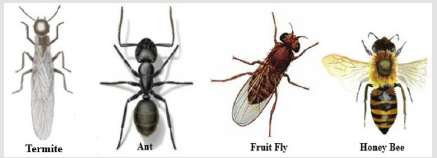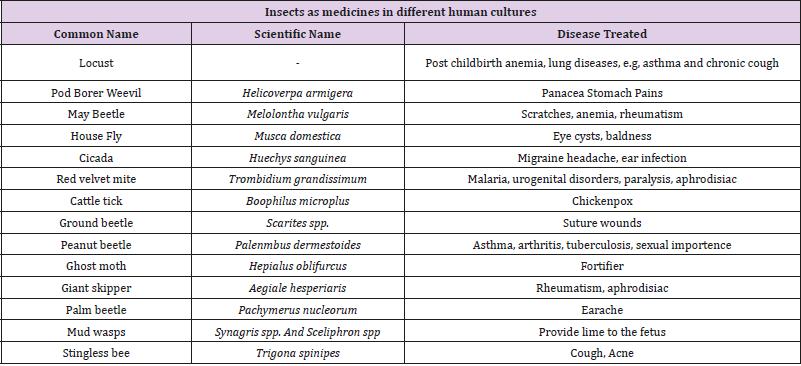Insects with Potential Medicinal Significance: A Review
Introduction
Pest Control means management or elimination of insects, wildlife, & rodents that have become pests of humans. In ancient cultures, insects were used as medicine, and today, scientists are studying and trying to rediscover many natural products from insects. Insects and insect-derived products are used in many parts of the world since ancient times as medicinal agents. Honey is applied to treat burns. Honey and beeswax combination used for several dermatologic disorders, includes psoriasis, tinea, pityriasis versicolor, atopic dermatitis and diaper dermatitis. Royal jelly used to treat postmenopausal symptoms. Bee and ant venom have reduced the number of swollen joints in patients with rheumatoid arthritis. Propolis, a hive sealant made by bees, has been utilized to cure aphthous stomatitis. Cantharidin, a derivative of the bodies of blister beetles, has been applied to treat warts and molluscum contagiosum. Combining insects with conventional treatments may provide further benefit. The medicinal uses of insects and other arthropods plays an important role to treat various maladies and injuries and has a long tradition can be effective and provide results [1]. Insects and other arthropods provide ingredients that have been a staple of traditional medicine for centuries in part of East Asia, Africa and South America.
Honey Bee Products Used as Medicine
To treat diseases, such as arthritis, rheumatism, pain, cancerous tumors and skin diseases Bee venom therapy have been used in traditional medicine. Bee venom contains a variety of peptides including melittin, apamin, ado lapin, the mast cell degranulating peptide, enzymes (phospolipase-A2), and amines like histamine and epinephrine and nonpeptide components with a variety of pharmaceutical properties. For the treatment of cancer cells, including renal, lung, liver, prostate, mammary gland as well as leukemia cells can be targets of bee venom peptides such as melittin and phospolipase-A2. Recently Moon et.al reported that bee venom can induce apoptosis in cancer cells (in human leukemic U937cells) the key regulators in bee venom induced apoptosis are Bcl-2 and caspase-3 through down regulation of the ERK and Akt signal pathway [2].
Treatment for Rheumatoid Arthritis
Bee venom induces apoptosis in rheumatoid synovial cells through a decrease in BCL2 expression and an increase in BAX and caspase-3 expression. Bee venom induces apoptosis through caspase-3 activation in synovial fibroblasts of patients with rheumatoid arthritis [3].
Treatment for HIV
Toxin found in bee venom can destroy Human immunodeficiency virus (HIV). Bee venom contains melittin that surrounds HIV virus as well as other viruses. This melittin is loaded with nanoparticles that attack an essential part of the virus’ structure. Nanoparticles are easy to manufacture in large quantities to supply them for future clinical trials [4].
Maggot Products
Maggot therapy is a type of biotherapy involves the introduction of live, disinfected maggots (fly larvae) into the nonhealing skin and soft tissue wound(s) of a human or animal for the purpose of cleaning out the necrotic (dead) tissue within a wound (debridement) and disinfection. There is evidence that maggot therapy may help with wound healing [5]. Maggot therapy divided into 3 processes:
a) debridement of wounds;
b) wound healing;
c) disinfection of wounds.
Debridement of Wounds: Application of maggots to the wound then cleaning and removal of necrotic tissue and debris (eschar) occur so that granulation and healing can begin. Maggots clean wounds by the extra- corporeal production of enzymes that digest the debris which the maggots then feed upon [6]. initially, the main enzymes identified in the maggot excretions/secretion (ES) is chymotrypsin and trypsin-like serine proteases, an aspartyl proteinase and a metalloproteinase. Ammonia secretion increases the pH to activate the serine proteases. The most active enzymes are produced by first instar larvae [7]. Wound Healing: It has an immunomodulatory role in the wound healing process 8 In particular, neutrophils, macrophages, lymphocytes, and the complement system respond to exposure to the MS. With neutrophils, the ES inhibit elastase, the respiratory burst, hydrogen peroxide production, and migration of these cells.
Elastase breaks down the extracellular matrix and delays epithelial repair, while oxygen radicals would probably have a similar effect. Concomitantly, the inhibition of neutrophil migration would help resolve the prolonged inflammatory response, to which they contribute, present in a chronic [8,9]. Disinfection of Wounds: ES able to kill bacterial infection of wounds, including antibioticresistant strains such as MRSA [10]. Many different antibacterial factors in dipterans, includes a range of AMPs such as Sarcotoxin- 1A, a cecropin-like molecule from the flesh fly Sarcophaga peregrine, which is more active against Gram-negative bacteria than Grampositive forms [11]. More recently lucifensin II was discovered and characterized from Lucilia cuprina and found to be identical to the L. sercata lucifensin except for one amino acid residue Thus, lucigenin’s are cationic AMP (antimicrobial peptide) has main activity against Gram-positive bacteria [12]. The anti-bacterial factors of the house fly, Musca domestica are also detected, because of its role as a vector of pathogens such as MRSA [13,14].
Fruit Fly
Fruit fly is the type of insect which can detect one of the treacherous diseases which we called “cancer”. Cancer cells exhibit a metabolism that is fundamentally altered as compared to that of normal cells [15,16] leading to changes in the tumor’s microenvironment, in lipid peroxidation activity and to a variety of potential intra-and extracellular cancer-specific markers. Thus, quantitative and qualitative variations of metabolites provide important information on cell condition [17,18].
Ant
The South American tree ant, Pseudomyrmex sp. commonly called as the samsum ant has venom which possesses many pharmacological effects such as reducing inflammation, relieving pain, inhibition of tumor growth, hepatitis treatment, and liver protection [19]. According to Bai, a primary alkaloid obtained from fire ant Solenopsis invicta exhibits anti angiogenic activity; this toxin has the ability to inhibit a series of kinases involving in angiogenesis mechanism. Polyrachisla melliden, a medicinal ant used in Chinese medicine, was confirmed to exert potent analgesic and anti-inflammatory actions [20]. Its therapeutic efficacy in the treatment of various inflammatory disorders had been reported [21]. Weak vision was treated with ant eggs mixed with an equal amount of white flour to make dough [22]. Most of the native healers used ants. Ants were put into canvas bags and put around the legs of paralyzed [23].
Termite
From a serviceable standpoint, termites are commonly used insects in traditional popular medicine [24-27]. A total of 45 termite species belonging to four families were recorded as being used by human populations, with 43 species used in the human diet or for livestock feeding and nine species used as a therapeutic resource [28]. Different species of termites are used to treat various diseases that affect human’s health. For e.g. Microkeratomes exiguous used for asthma, bronchitis, influenza, whooping cough, flu. Nasturtiums macrocephalus is used to treat asthma, leakage, bronchitis, ‘catarrh in the chest’ coughs, influenza, sore throat, sinusitis and tonsillitis [29] (Figure 1) (Table 1).
Conclusion
The purpose of the present study is to focus on the use of insect as a natural product having potential source as a medicine that is useful in curing as well as giving protection from the diseases. Here are the significant recent advances in developing insect as potential new alternative medicinal drugs. This is an exciting and rapidly expanding new field since insects are hugely variable and have utilized an enormous range of natural products to cope up the environmental perturbations for many years.
More BJSTR Articles: https://biomedres01.blogspot.com/




No comments:
Post a Comment
Note: Only a member of this blog may post a comment.